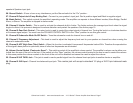
©American Audio® - www.americanaudio.com - V-01 Series™ Power Amplifier User Manual Page 14
OPERATING MODES: Always configure your amplifier operating mode before beginning operation. If you want to change it dur-
ing performance. You must
decrease the gain controls to their lowest levels to protect the speakers from any popping noise.
Stereo Operation - Page 18/Figure 17 details an example of a typical stereo set-up. Connect your inputs into channels one and
two of the amplifier. Connect your speakers to the outputs on the rear of the amplifier. Be sure that your front gain controls are turned
down to their lowest level (full counter-clockwise). Turn your amp on. Turn your input source level up. Use your front gain controls to
regulate the output volume. Be sure not to raise the volume to the clip level, however an intermittent clip signal is acceptable.
Mono Bridge Operation - Page 18/Figure 18 details a mono bridge set-up. Be sure your amplifier and all other audio equipment
is powered down. Flip the Stereo/Mono Bridge switch to the Mono Bridge position. Connect an input signal to channel one. Connect
your speaker across th
e red output binding post, or pin 1+, 2+ of channel one speakon output jack on the rear of your amplifier. Turn
your equipment on (your amplifier should always be the last item you turn on). Apply an input source signal to your amplifier. Turn
channel two gain up. Use the channel one gain to regulate your amplifier output.
Bridged-Mono Mode Caution - The voltage across the output terminals of a bridged V-01 Series™ amplifier may equal or exceed
100 volts RMS and may be as high as 130 volts. Use fully insulated CLASS ONE wiring, and the load must be rated for up to 2500 watts
(@4 ohms)
Parallel Mono - “Parallel ” ties the two channel line inputs together so that they will both be driven by the same signal, without the
need for external jumpers or wiring. Both amplifier channels will operate independently. Though they carry the same signal, their gain
controls affect only their respective channels, and they both must use their respected speaker outputs. Never attempt to parallel the
speaker outputs, this may cause serious damage to your amplifier! This mode is recommended when using the V-01 Series™ to run
bass speakers, to achieve better low end. To run in parallel mono mode connect your system as you would if you were going to run in
stereo mode. Then flip the mode switch to “MONO.” Be sure the amp is off or the power is disconnected before making any changes.
Subwoofer Mode - This mode sends low frequencies to your speakers without the use of an external cross-over. The subwoofer
operation can be operated in stereo, mono, or bridge mono modes. Change the different operating modes by flipping the mode switch
on the rear of the unit to your desired operating mode. Also, set the subwoofer mode switch to the subwoofer position. Use the frequency
selector to adjust the subwoofer output frequency from 20Hz to 200Hz. The different subwoofer modes are listed as follows;
Bridge Subwoofer - This operation allows you to get the most possible power out of your amplifier for the sole purpose of running a
high powered subwoofer loudspeaker in mono. To avoid amplifier overheating, never run the amplifier below 4 ohms in this mode. In
this mode you may use the frequency adjustment on the rear of the amp, to control the frequency output level. Frequencies may be
adjusted from 20Hz to 200Hz. Page 17/ Figure 15 details a typical Bridge Subwoofer set up.
Stereo Subwoofer - This operation is similar to the Bridge Subwoofer operation but in stereo. This operation allows you to run several
subwoofers down to a minimum of 2 ohms. To avoid amplifier overheating, never run the amplifier below 2 ohms in this mode. Set up
this mode as you would a standard stereo set up. Be sure both channels are set to “SUBWOOF.” In this mode you may use the frequency
adjustment on the rear of the amp, to control the bass frequency output level. Frequencies may be adjusted from 20Hz to 200Hz. Page
17/ Figure 16 details a typical Stereo Subwoofer set up.


















